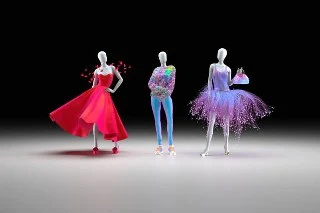Digital Fashion
Digital
fashion is a visual representation of clothing created using computer
technology and 3D software. Both discuss how digital fashion is applied to the
way businesses operate after the digitization of fashion. In addition, there are
various business requirements that include intellectual systems, big data, and
knowledge technology.
Digital
fashion is a new, growing field in fashion design, which has suddenly become
relevant due to its non-physical essence. It is a procedural tool to assist in
design but it is also a new fashion space, culture, and community. The term
refers to a practice that creates three-dimensional virtual clothing as a
prototype/sample simulation for potential physical clothing, data physical-digital representations, or end products within themselves, worn only in
virtual spaces where clothing-clad avatars are intimately associated with our
physical bodies and "Digital fashion" integrates fashion and gaming
but redefines the professional role of a fashion designer. The designer became
a digital craftsman, using tangible technical fashion knowledge, yet, and
suddenly restored artistic freedom with the endless possibilities of
experimenting in 3D.
You Also May Know: Silhouettes fashion | Different types of silhouettes fashion
Advances
in technology, especially 3D software, are making it easier to create digital
fashion. What currently takes 3-5 hours may eventually become instantaneous.
Initially,
designers were digitizing their existing textile designs. But with
sophisticated software, they can create digital clothing from start. They can
even add imaginative items and materials that are impossible in real life, as
well as add AR effects and filters.
Digital fashion history
The
fashion industry, in general, has paved the way for the introduction of digital
fashion with more technologies in the industry, such as virtual dressing rooms
and gamification of the fashion industry. The digital fashion market has been
booming since 2010 and the concept of virtual clothing has come to us from
video games. In 2015, digital fashion began to take on the shape it now has.
Designers are creating new collections and copying the look of existing fashion
brands in VR. Cat Taylor is thought to be the creator of the whole scene, a 3D
designer known alias Cattytay. He created the DiGi-GXL project, specializing in
creating 3D animation, and was the first to port Balenciaga, Gucci, and
Off-White in the digital world. In 2018, Virtue Agency and Scandinavian brand
Carling became the first to start selling virtual clothes. The most expensive
piece of virtual clothing to date is The Fabricant's Iridescent Dress, which in
May 2019 sold for a record $ 9,500. Since the onset of the 2020 epidemic, the
fashion industry has suffered strong economic losses as sales have fallen and
jobs have been lost, but since then it has learned to recover digitally through
virtual clothing, catwalks, and showrooms.
Digital fashion environmental impact
The
environmental impact of digital fashion depends on maintaining the digital,
blockchain, and cryptocurrency systems that are used to create and trade, as
well as the digital world in which we use them. In short, the problem is the
use of energy. The major blockchains and cryptocurrency technologies on which
NFTs operate follow a consensus approach that requires large computing power to
verify records and transactions. Overall, wearing a digital fashion item can be
a 97% low carbon footprint vs. physical equivalent. And if we replace 1% of
physical clothing with virtual clothing, the industry's annual carbon footprint
would be reduced by 35 million tons, says DRESSX. Only digital clothing has
much less impact on the environment and if it proves that the customer needs to
have new, exciting clothes all the time, it will be a great win for durability,
"said fashion co-founder Denitsa Damyanova.
Benefits of digital fashion
Digital
fashion is the result of computer-generated images and uses digital
prototyping and fit technology. Digital fashion is a virtual fashion experience
that enriches imagination and creativity, which is rooted in durability. It is
a renaissance movement in the fashion space, which goes beyond the dynamics and
rigidity of the traditional fashion system. It represents a revolution against
the polluting nature of physical fashion. An eco-friendly alternative, digital
fashion creates and consumes nothing but data and keeps your wardrobe free of
clutter.
In the meantime, they've jumped on some secondary research and taken some existing emissions data from a recent Ericsson report. Their calculations are based on a report by Carbon Trust which indicates that white T-shirts for men are responsible for emitting 6.5 kg of CO2e into the atmosphere, on the other hand, it takes one hour to create a digital garment that requires energy that emits 0.312 kg of CO2e, Leading to their suggestive calculation that: "Dress-X, the total carbon footprint of a digital item production is 95% less than the average production of a physical garment."









0 Comments